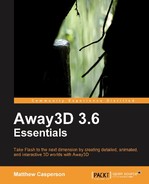Book Description
Take Flash to the next dimension by creating detailed, animated, and interactive 3D worlds with Away3D
- Create stunning 3D environments with highly detailed textures
- Animate and transform all types of 3D objects, including 3D Text
- Eliminate the need for expensive hardware with proven Away3D optimization techniques, without compromising on visual appeal
- Written in a practical and illustrative style, which will appeal to Away3D beginners and Flash developers alike
In Detail
Away3D is one of the most popular real-time 3D engines for Flash. Besides creating various detailed 3D environments you can also create animated 3D scenes, use various special effects, integrate third-party libraries, and much more. The possibilities of using this engine are endless. But will you be able take full advantage of all these features and make a 3D application that is picture perfect?
This is the best book for guiding you through Away3D, and the possibilities it opens up for the Flash platform. You'll be able to create basic 3D objects, display lifelike animated characters, construct complex 3D scenes in stunning detail, and much more with this practical hands-on guide.
Starting with the very basics, this book will walk you through creating your first Away3D application, and then move on to describe and demonstrate the many features that are available within Away3D such as lighting, shading, animation, 3D text, model loading and more. With the help of this comprehensive guide to all the information you ever needed to use Away3D, you'll find yourself creating incredibly detailed 3D environments in no time.
You begin with an overview of downloading the Away3D source code and configuring various authoring tools like Flex Builder, Flash Builder, FlashDevelop, and Flash CS4. Next you ease your way through creating your first primitive 3D object from scratch, then move on to creating stunning 3D environments with incredibly detailed textures and animations. You will make applications react to mouse events, with the click of a mouse – literally, learn ways to focus your camera and perfect your creation by viewing it from all angles, and take your Away3D application to the next level by overcoming the limitations in default Away3D algorithms. You will also learn optimization techniques to obtain the best performance from Away3D, without compromising on visual appeal.
Create stunning real-world 3D Flash applications, right from displaying your first sphere to creating entire 3D cities, with plenty of tips to help you avoid common pitfalls
Table of Contents
- Away3D 3.6 Essentials
- Table of Contents
- Away3D 3.6 Essentials
- Credits
- About the Author
- About the Reviewers
- www.PacktPub.com
- Preface
- 1. Building Your First Away3D Application
- Choosing between Away3D for Flash Player 9 or Flash Player 10
- Downloading Away3D
- Creating an empty project for Away3D
- Targeting the Flash Player 10 runtime
- Creating the initial application
- Running Away3DTemplate
- Positioning objects in a 3D scene
- Extending Away3DTemplate to populate the scene
- Running SphereDemo
- Summary
- 2. Creating and Displaying Primitives
- 3. Moving Objects
- 4. Z-Sorting
- 5. Materials
- The difference between textures and materials
- Resource management
- Defining colors in Away3D
- Pixel Bender
- Lights and materials
- Shading techniques
- Applying materials
- Loading textures from external files
- Summary
- 6. Models and Animations
- 7. Cameras
- 8. Mouse Interactivity
- 9. Special Effects with Sprites
- 10. Creating 3D Text
- 11. Extrusions and Modifiers
- 12. Filters and Postprocessing Effects
- 13. Performance Tips
- Index
